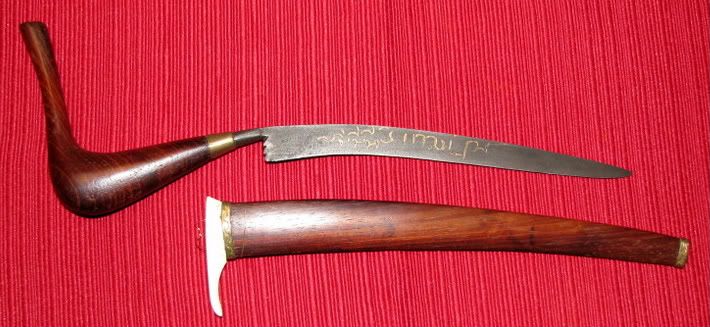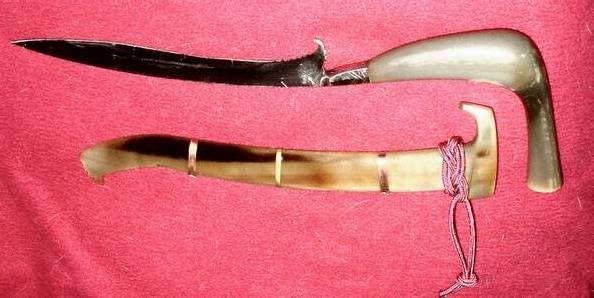
 |
|
|
#1 |
|
(deceased)
Join Date: Dec 2004
Location: Portugal
Posts: 9,694
|
I hope the pictures are clear enough for a judgement.
Seller dated this example as from the 18th century, but i doubt. Most examples i see selling in the Net are tagged end 19th century, but i don't have the knowledge to compare them with mine. I assume this is a real action specimen and not just tourist stuff; the blade is quite strong, the steel looks fine and its spine is rather thick. Coments will be so much welcome. Fernando |
|
|

|
|
|
#2 |
|
(deceased)
Join Date: Dec 2004
Location: East Coast USA
Posts: 3,191
|
nice example you have there and it's a 19th century piece for sure.
Congrats Lew |
|
|

|
|
|
#3 |
|
Member
Join Date: Dec 2004
Location: Inland Empire, Southern California USA
Posts: 160
|
Very nice Fernando. Lew is right, it's a nice old one. Here is an example of mine, much newer and tourist perhaps. I'm not sure what it says on the blade, but I wouldn't be surprised if it said, Welcome to Sumatra, have a nice day.
  
|
|
|

|
|
|
#4 |
|
(deceased)
Join Date: Dec 2004
Location: Portugal
Posts: 9,694
|
Thank you very much for your observation and kind coment, Lew.
Thank you Stephen; now i can see a newer one, to compare. Fernando |
|
|

|
|
|
#5 |
|
(deceased)
Join Date: Dec 2004
Location: East Coast USA
Posts: 3,191
|
Fernando
Btw Your dagger has a nice laminated blade  Here is an older one like yours for comparison. Naga I like the beautiful wood on yours Here is an older one like yours for comparison. Naga I like the beautiful wood on yours  Lew |
|
|

|
|
|
#6 | |
|
Member
Join Date: Nov 2006
Location: The Netherlands
Posts: 2,237
|
Hello Lew,
Firstly agree that the rencong is (late ?)19th century. But Lew : Quote:
Best regards, Willem |
|
|
|

|
|
|
#7 |
|
(deceased)
Join Date: Dec 2004
Location: East Coast USA
Posts: 3,191
|
Willem
I did not say older than I said older like yours referring to Fernando's piece. I also like the wood on nagas newer piece it has lovely striped grain to it  . .Lew |
|
|

|
|
|
#8 | |
|
(deceased)
Join Date: Dec 2004
Location: Portugal
Posts: 9,694
|
Quote:
 . .Fenando |
|
|
|

|
|
|
#9 |
|
Member
Join Date: Nov 2006
Location: The Netherlands
Posts: 2,237
|
Yes some age and corrosion is good to to see the lamination.
some more examples/ Old blades. Top and bottom with clear lamination. |
|
|

|
|
|
#10 |
|
Member
Join Date: Mar 2006
Location: Room 101, Glos. UK
Posts: 4,259
|
here's mine with green horn grip and scabbard. it's interesting how the internal blade cut out is made from one side & covered by a narrow strip of horn held by the copper bands.

|
|
|

|
|
|
#11 |
|
Member
Join Date: Mar 2005
Posts: 373
|
I accidentally dropped this and apparently the bands conceal the joints used in hollowing the sheaths out. Is this horn or a corral material? How can you tell the differences?
Steve |
|
|

|
|
|
#12 |
|
Member
Join Date: Nov 2006
Location: The Netherlands
Posts: 2,237
|
Steve,
Your rencong is quite uncommon. Most scabbards are from 1 solid piece of wood, indeed hollowed from the back side which is than covered with a strip of wood again. In some cases so tight that I wondered if there was a strip. Than I have now one rencong with a scabbard made out of one piece, and also 1 with a scabbard made out of 2 separates sides (left and right) Buffalo horn scabbards are rare, but IMO more recent and/or made for 'tourist' rencongs. I have seen a few Hulu dandan rencongs with scabbard mouths made of ivory. So far my observations. Although I love these weapons I don't have much documentation on them accept for a free download that came from www.mytribalworld.com Best regards, Willem |
|
|

|
 |
|
|